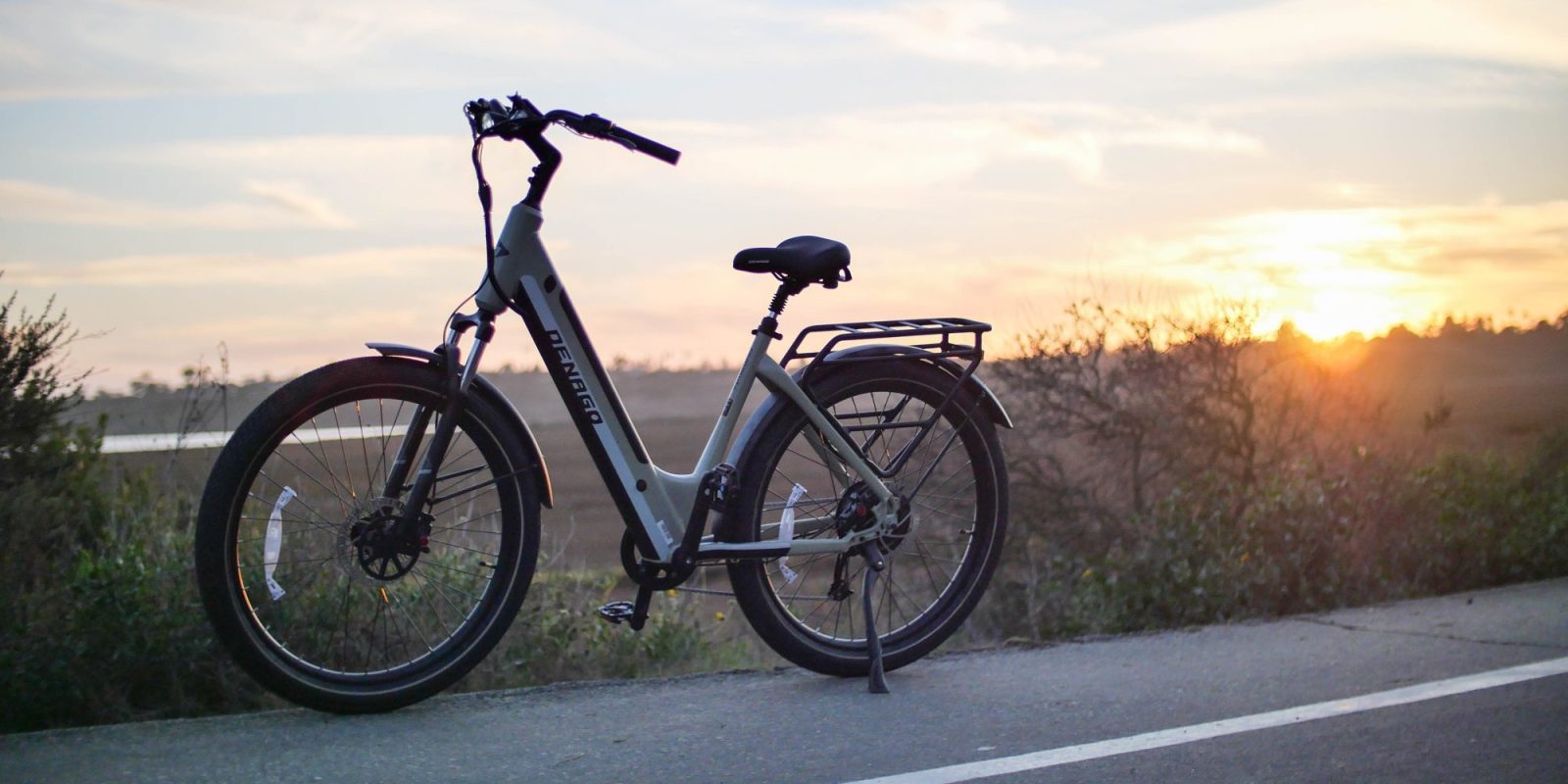
Denago sent us a review copy of the step-through model of its $1,799 Commute bike, and we’ll take you through what we thought of this big, well-equipped, and comfort-focused bike.
The Denago Commute is a bike that puts a premium on rider comfort and has quite a few built-in features that won’t leave you wanting for much. At $1,799, it’s not quite a budget bike, but it’s still reasonably priced compared to the field given all of its extras, though there are still a few different decisions we wish they would have made.
Denago Commute Step-Thru tech specs
- Motor: 500 W rear geared hub motor with 50 Nm torque
- Top speed: 20 mph (32 km/h) throttle, 28 mph (45 km/h) pedal assist (Class III)
- Range: 45 mi (72 km) est.
- Battery: 48V/13.6Ah (652.8 Wh), frame-integrated, removable, included 3 amp charger
- Drivetrain: Microshift 8-speed, chain
- Max load: 280 lb. (127 kg) max rider weight, 55 lb. (25 kg) load limit on rear rack.
- Frame & Fork: 6061 aluminum
- Weight: 66 lb. (30 kg)
- Suspension: Fork & seatpost suspension
- Brakes: Zoom Hydraulic disc brakes, 180 mm rotors
- Extras: Monochrome LCD display with speedometer, battery gauge, PAS level indicator, odometer/tripmeter and PIN code lock; left-side thumb throttle; cadence sensor; metal front and rear fenders; rear rack; kickstand; integrated headlight; rear reflector with battery operated tail light (2x AAA)
I mentioned above that the bike is big, and I don’t say that lightly. Denago’s size chart suggests S/M size for riders 5’0″-5’9″ and L/XL for 5’9″-6’4″. But I’m 6′ and still wished the saddle could go lower than its lowest position (38″ from the ground) on the L/XL bike. I wasn’t able to test whether the S/M size would feel better for me on the whole, but definitely consider test-riding if you’re on the borderline of Denago’s sizing chart. And if you’re too big for most bikes, this might be just what you’re looking for.
This size does make for a smooth and comfortable ride, along with the bike’s large 27″ x 2.6″ tires, suspension in both the seatpost and fork and its wide padded saddle. The bike does have a “walking mode” activated by holding a handlebar button, which helps if trying to push the huge bike up an incline, etc.
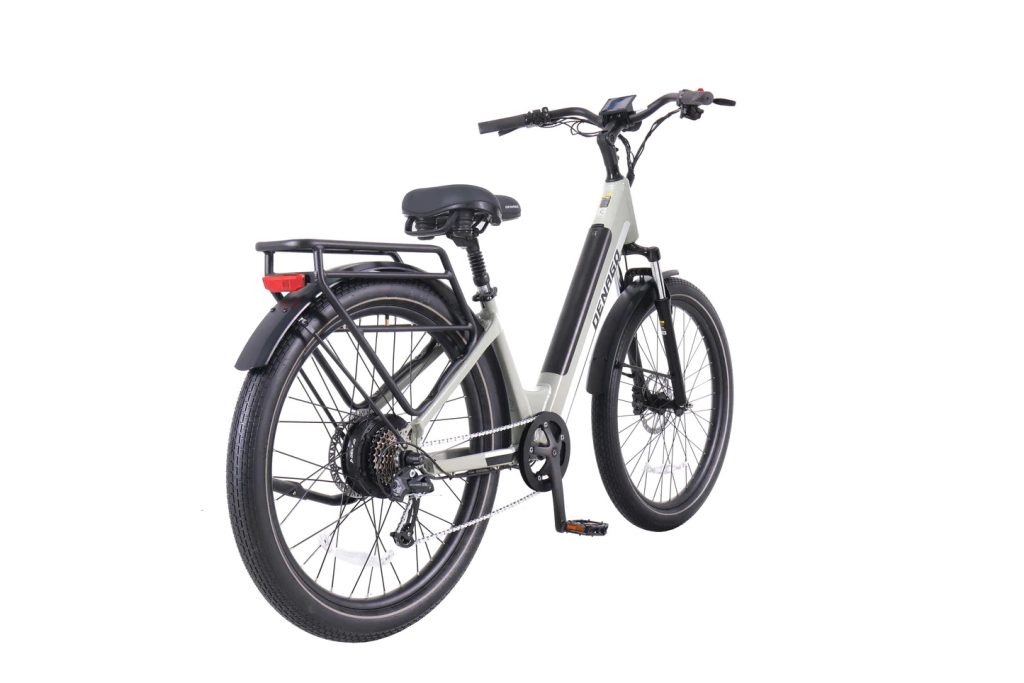
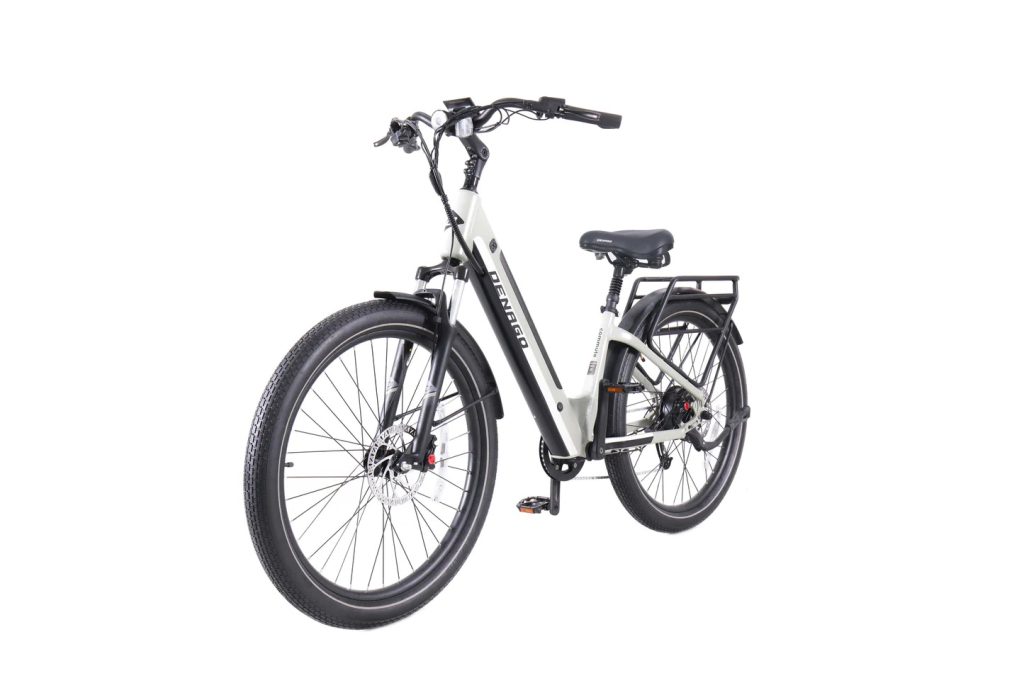
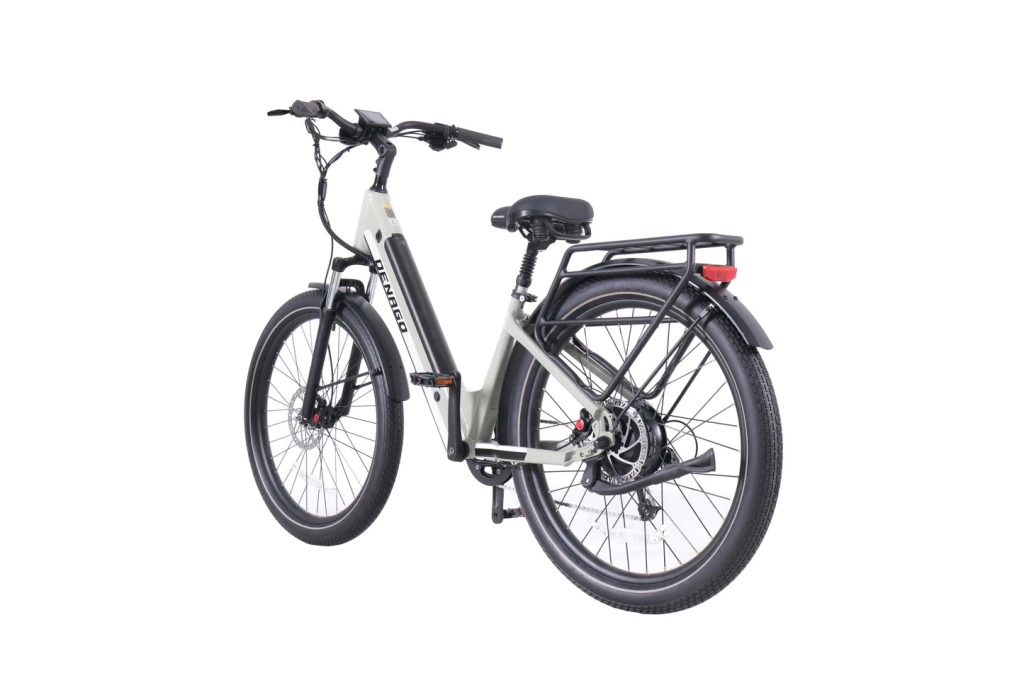
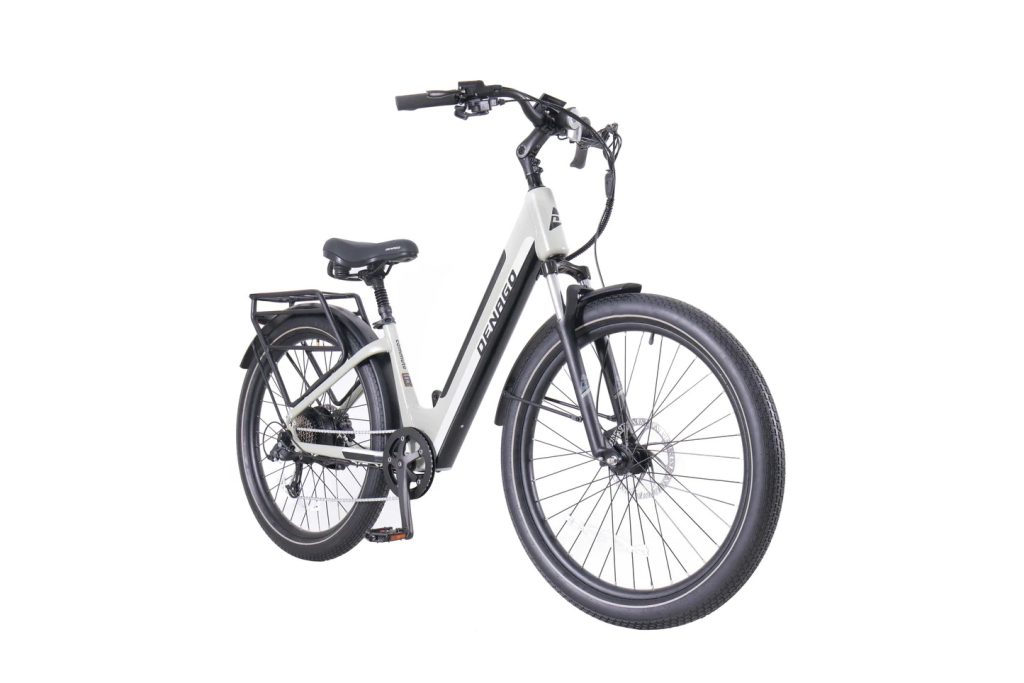
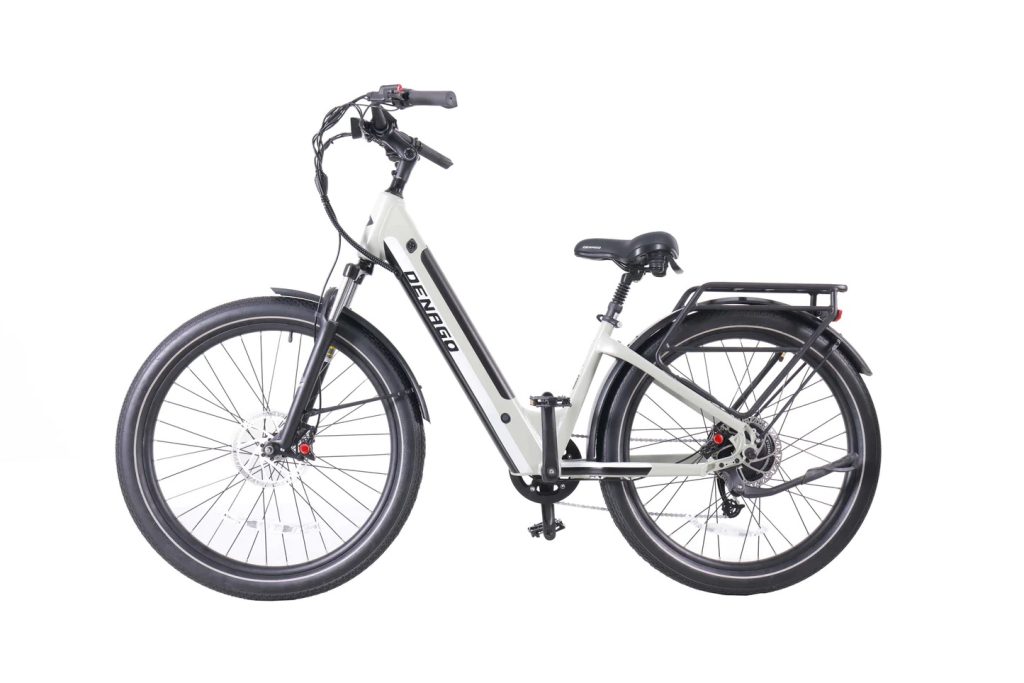
Denago says that despite the bike’s name and target market (commuters), it has actually been surprisingly popular among older customers due to its comfort, large size, and upright seating position from the swept-back handlebar and adjustable stem. I can certainly see how this could be the case. It’s quite a cushy ride. And the step-through design makes the bike easier to mount, even if it is quite big.
The bike comes well-equipped with lots of nice features, like metal front and rear fenders, monochrome digital display, adjustable stem, hydraulic disc brakes, rear rack, headlight, and a sturdy kickstand (rear-mounted, so don’t forget to kick it up like I always do).
Two extras we’d like to see are some sort of water bottle/drink holder (you’ll have to find your own way around this, there are no built-in mounts on the frame) and a taillight integrated into the bike’s battery. It does come with a taillight, but it requires 2x AAA batteries to operate, and needs to be turned on manually separate from the bike/headlight.
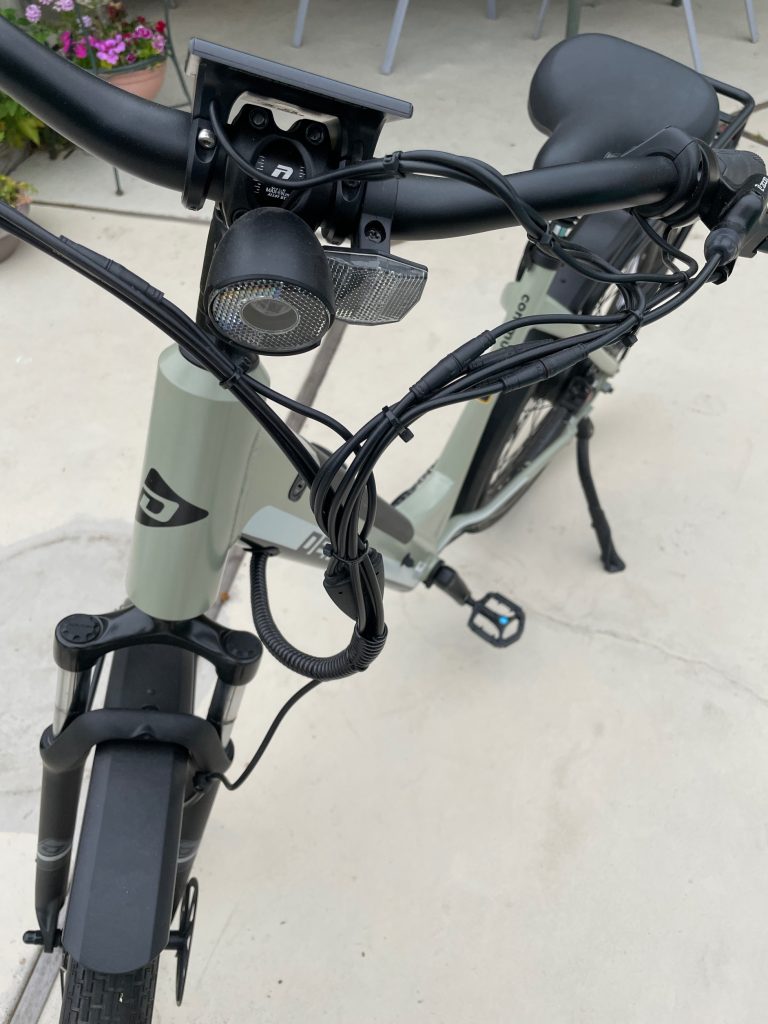
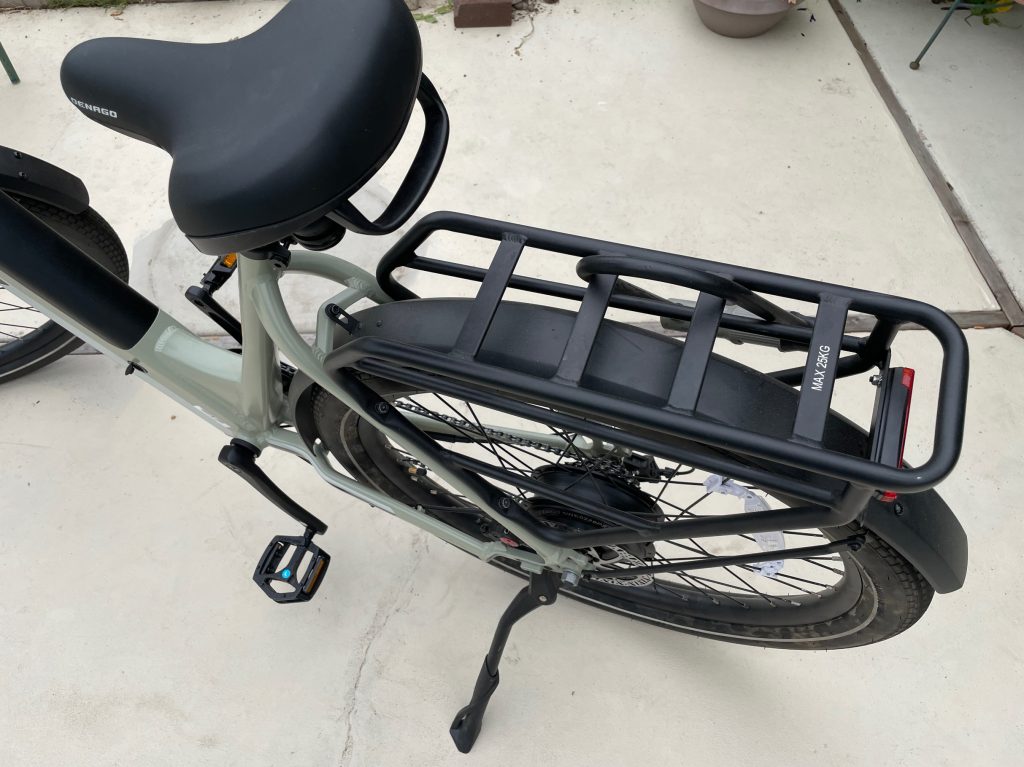
The bike’s cadence sensor and pedal assist can lead to some quirky movement. Neither throttle nor pedal assist can be used from a complete dead stop, both require you to get moving first. So if you happen to be on a hill or any sort of strange terrain, it takes effort to get this big 66 lb. bike moving before the electro-motion kicks in (though the aforementioned “walking mode” can be used in these circumstances).
And cadence sensors are tough for group rides too, because it’s hard to exactly pace whoever you’re riding with (unless everyone is on the same bike model). Throttle could be used in these cases, but the thumb throttle doesn’t really allow for precise speed control either.
But then, this is a matter of taste. Some prefer cadence sensors because they can “ghost pedal,” without having to put even a small amount of force into pedaling, which can help for those with injuries or bad joints (see: the aforementioned elderly). But the throttle already allows for that, so I find cadence sensors somewhat redundant. I’d prefer throttle for no pedaling, torque sensor for pedaling, and different pedal-assist levels for different speeds.
If I’m already spending $1,799 on a bike, I feel like I’d rather have a torque sensor for ~$100 more, since in my opinion a torque sensor just gives a much better experience. Denago’s fat tire bike has a torque sensor on a $1,799 bike (with bigger battery, motor and tires, but not as many extras), so it can certainly be done.
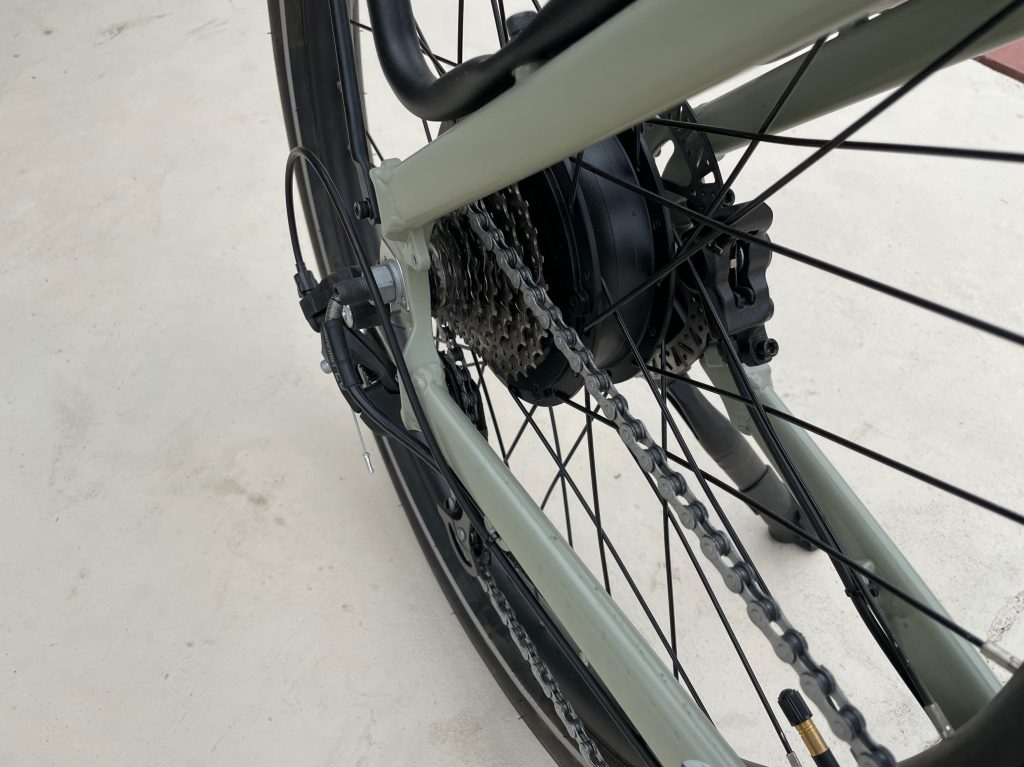

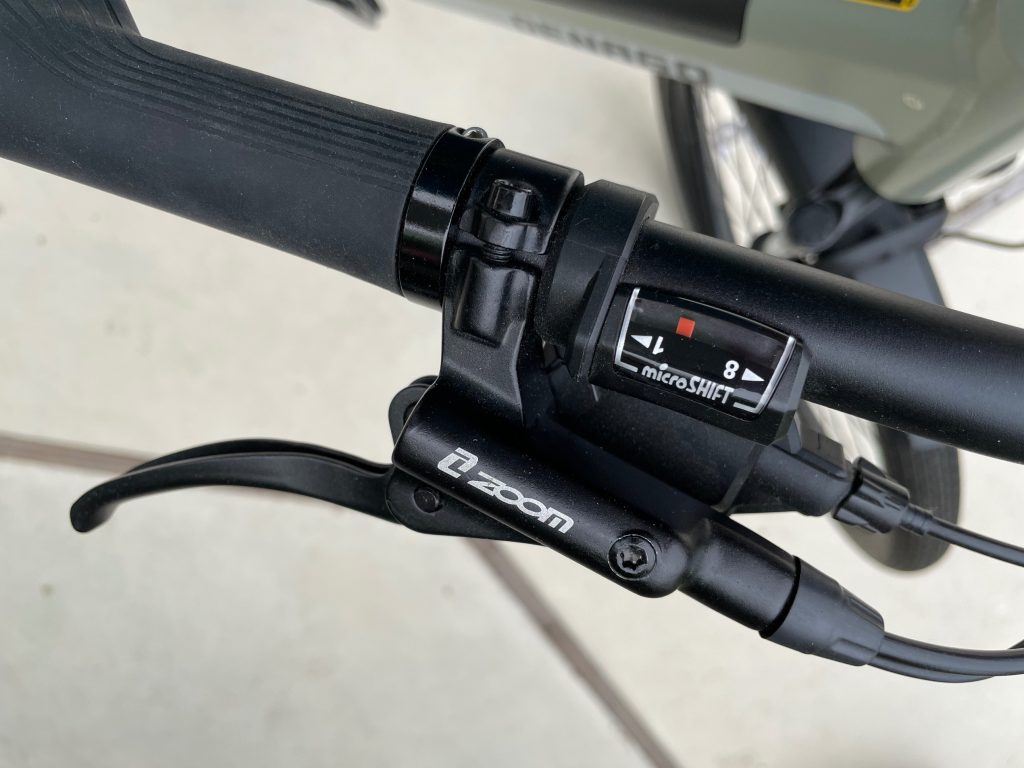
The same goes for a belt drive, which would cost more to add than a torque sensor, but which I also prefer. Especially for a commuting bike, where commuters might put additional emphasis toward avoiding the risk of chain grease on their business clothes.
Part of this is because I particularly disliked the MicroShift 8-speed shifter. It felt like I could never get into and stay in the gear I wanted to be in, and the configuration of the shift levers is simply not intuitive. Perhaps I’ve just been spoiled by belt drives.
For a bike that is otherwise so well equipped, these are two pretty big headline features that I think would be nice to have. $1,799 isn’t in the “expensive bikes” category yet, but it’s definitely not the cheapest bike out there, so as long as I’m spending a bit more on a bike with lots of extras, I’d like these to be a couple of those extras, even if it knocked the price up another couple hundred dollars.
To keep an eye on things, the bike has a somewhat plain monochrome display with all the basic information you’d expect – speed, battery, odometer, and so on – and also includes a PIN code lock. The display is serviceable, but if you wear polarized sunglasses like I do, it becomes much less readable:
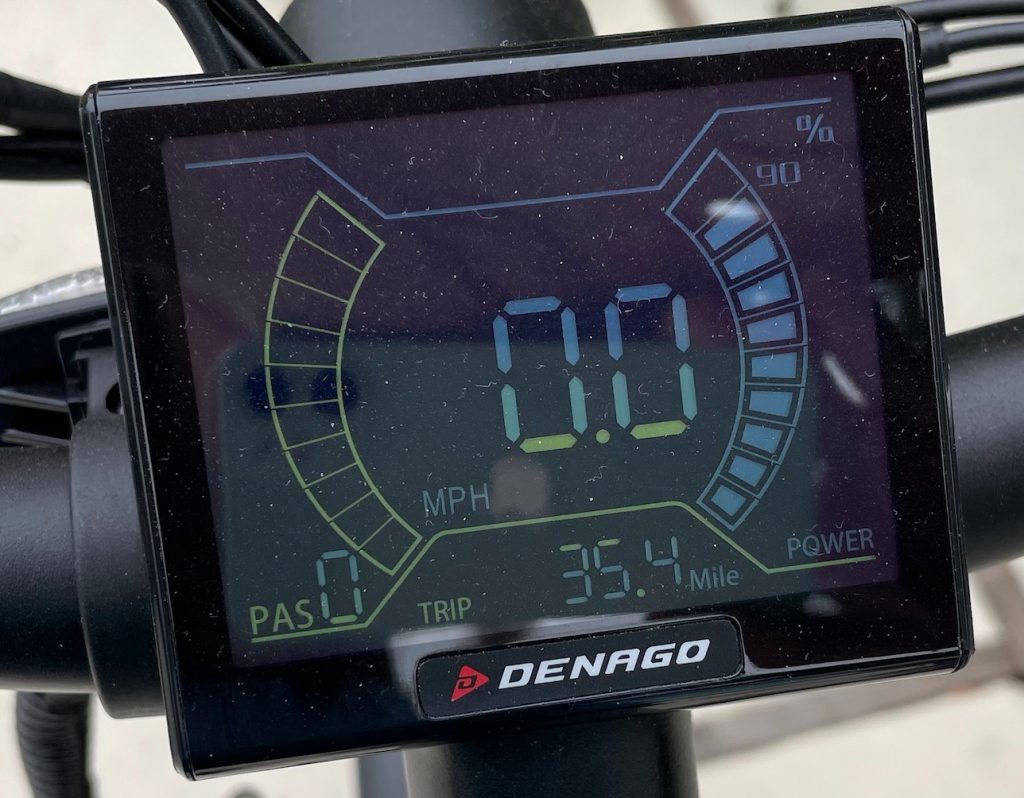
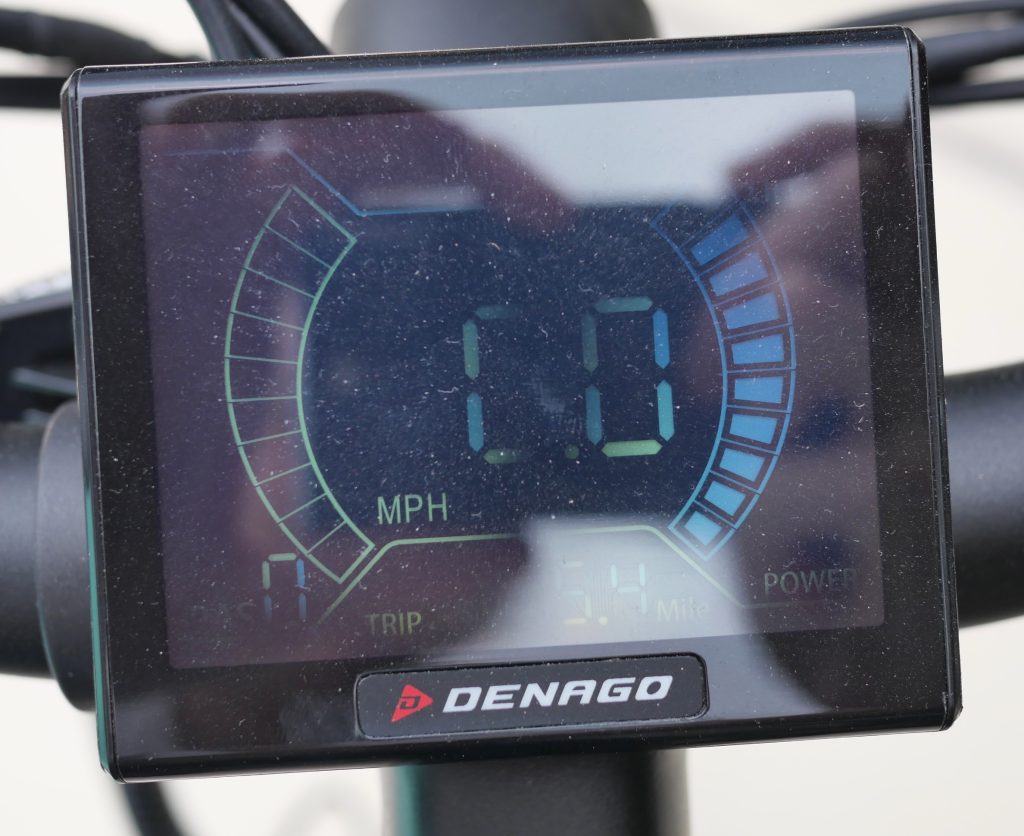
You can’t turn on the screen while the bike is plugged in, so if you want to check charging mid-charge, you’ll have to rely on the red/green/blue LEDs on the battery itself, or LEDs on the rather large external 3 amp charge brick (which gets you a full charge in ~4.5 hours).
The battery on the Denago Commute impressed me with its range and durability. While e-bike range is a difficult topic because riding situations vary so widely – terrain, speed, rider weight, and how much pedaling they like to do (I’m a 155 lb. lightweight and a compulsive pedaler, which both extend my range) – it felt like this bike has more than enough range for its commuting audience. Denago says this bike has 45+ miles of range, though with my average riding patterns I would get around 60. But again, I can’t stop myself from pedaling, so if you just like to sit back and use the throttle, you will get a lot less distance than me.
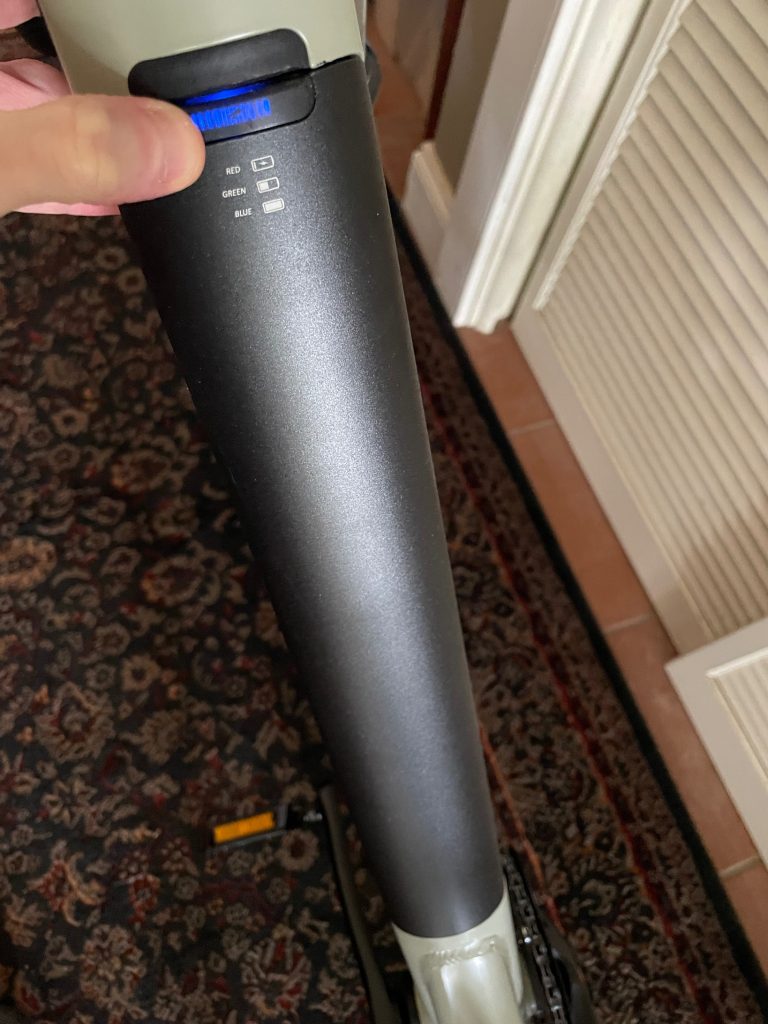
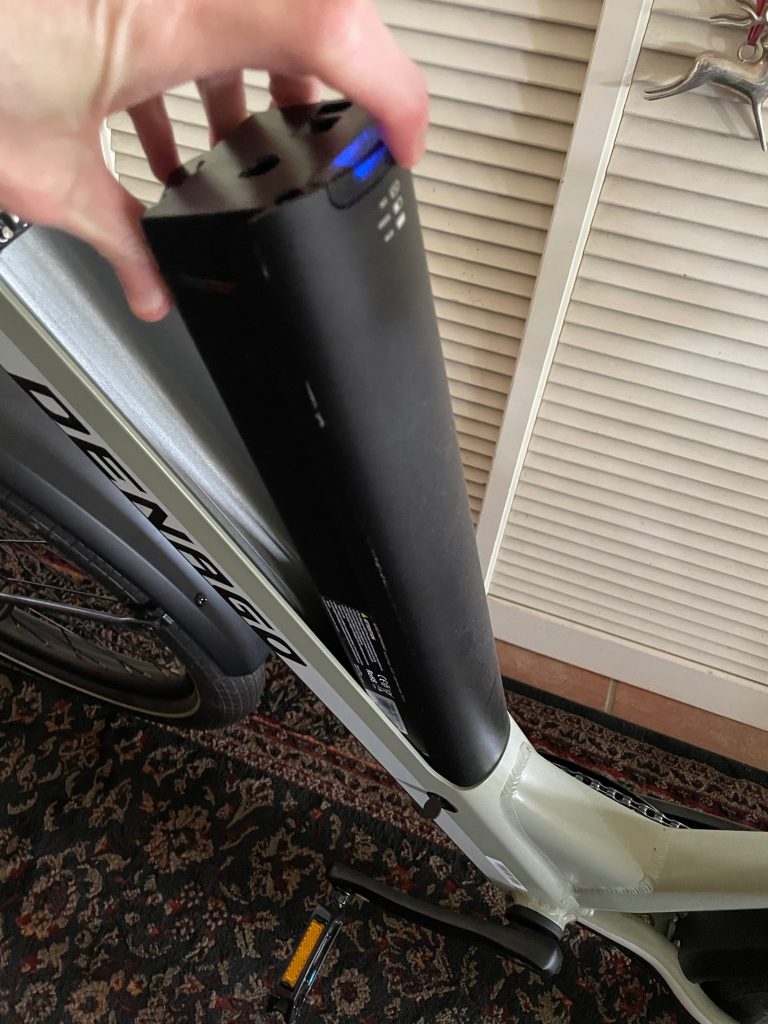
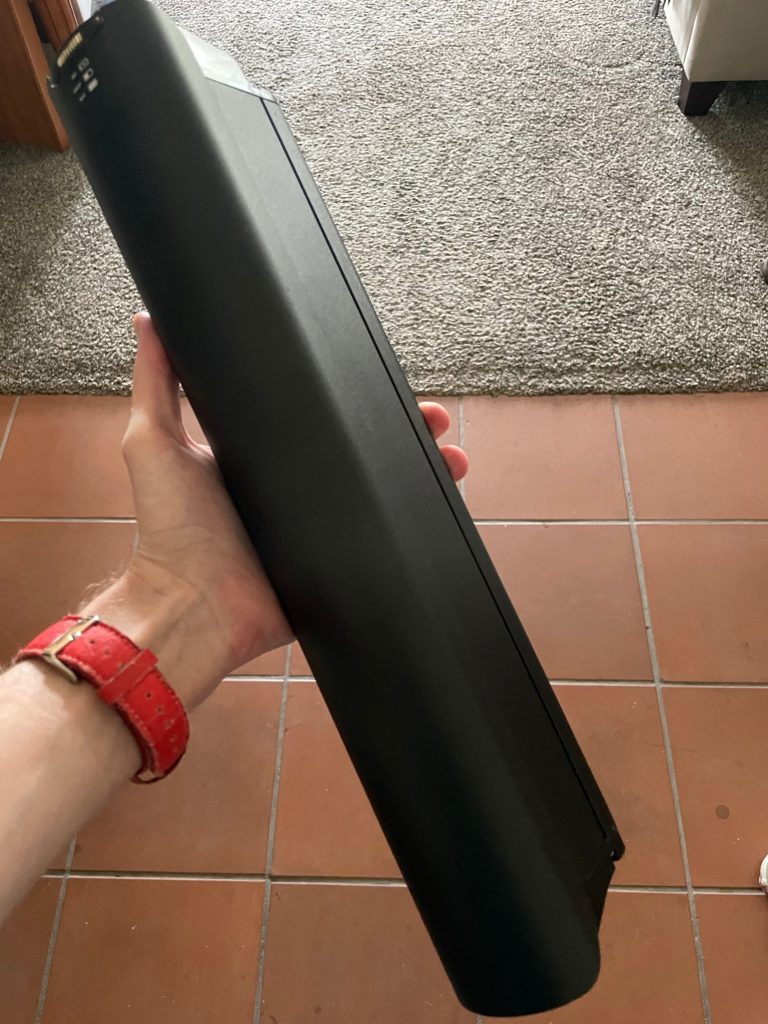
The battery is removable, so can be charged at home or while attached to the bike. The battery weighs just under 8 lb. (3.6kg) and is pretty easy to carry in one hand.
But I mentioned durability – right after I got this review bike, I sustained an injury that made me unable to ride for several months. So I also happen to know that this bike will maintain a charge for several months with little to no vampire drain. Not bad! Not a common point that we get to review, but here we are.
At $1,799, the Denago Commute is a reasonably well-priced bike compared to the competition. There are a few other features we’d like to see on it, but those would add to the price and perhaps take it out of the sub-$2,000 tier, or would have to replace some of the other long list of features already included on the bike. As is, the bike does include a laundry list of most of the features you’d want on a bike this price, which makes it a good buy for someone looking for a big, exceptionally comfortable bike with a big battery.
FTC: We use income earning auto affiliate links. More.





Comments